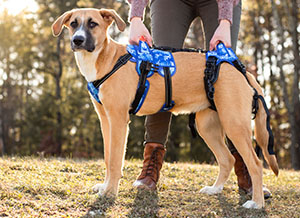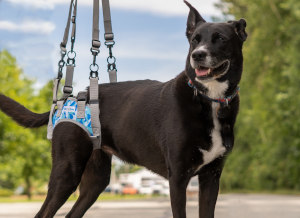- August 2, 2023
5 Things You Need to Know When Buying a Support Harness for Your Dog

Dog lift harnesses can help your pet with a wide range of mobility issues. Support harnesses are designed to help senior dogs with joint pain, assist injured pets in staying mobile, and give paralyzed pets the support they need to reduce pressure on their back legs. A lifting harness is a tool that every paralyzed dog or cat needs to move around the house.
Before buying a lifting harness for a paralyzed or injured pet, you need to understand how harnesses are used, how a harness can benefit your pet (and you), and where your dog needs the support. Continue reading to learn everything you need to find the right support for your pet.
5 Things You Need to Know When Buying a Support Harness for Your Dog
1. Why Paralyzed Pets Need a Lifting Harness
We know that every paralyzed pet needs a wheelchair, but do they need a harness too? Every paralyzed pet will need the support of a harness at some point. A pet wheelchair is ideal for helping your dog get exercise and enjoy the outside, but there are circumstances where a harness is the better option. A lifting harness is easy to use, and your dog can go anywhere in it.
Choosing the right lifting harness can help a mobility challenged pet live an active and healthier life.
2. When to use a lifting harness for your dog
The first thing you need to determine is when does your dog need support most? A lifting harness can easily be used with your dog’s wheelchair and can come in handy in plenty of situations. Here are just a few reasons why every paralyzed pet needs a support harness:
Emergency Bathroom Breaks
Sometimes your dog really has to go, and you may not have the time to get your dog into their wheelchair. A lifting harness is perfect for those late night trips outside and emergency potty breaks. A harness is compact, easy to store, and quick to put on your dog and take them outside.
Getting In and Out of the Car
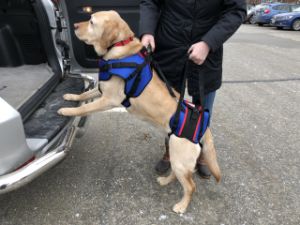
Senior dogs and pets with mobility issues can have a hard time jumping in and out of the car.
A harness is a safe way to lift them into the car without straining your back or worrying about your dog falling. By providing lifting support, you can safely help your dog in or out of the vehicle in a controlled manner. Without a harness, one bad jump out of the car could put your pet at risk of serious injury.
Safely Lifting Your Pet Off the Floor
It’s no secret that elderly dogs struggle to get up off the floor. Arthritis, joint pain, and leg weakness contribute to your dog struggling to stand up. It’s not uncommon for dogs with stiff or painful joints to become less active and sleep more, which compounds their mobility struggles. A canine support harness allows you to help your dog to stand and find its balance.
Helping Your Dog Get Around Inside
A harness can help you maneuver your paralyzed pet indoors to navigate tight spaces, especially if you live in an apartment or home with narrow hallways and doorways that your dog can’t easily fit through while in their wheelchair.
Supporting Your Pet as They Climb Up the Stairs
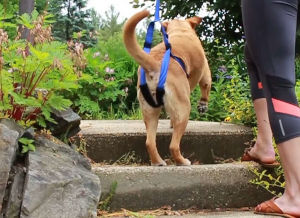
When a pet’s front or back legs lose strength, the stairs can be tricky to navigate. A dog with weak front legs often struggles to control how fast they go down the stairs. Some dogs may pick up speed as they descend and seem like they’re falling. Not only is this unsafe and causes injury, but an older dog may also refuse to use the stairs on their own.
Climbing up the stairs can be challenging as well. A dog with weak back legs may not have the leg power to push itself up each stair tread. Dogs that can use the stairs on their own may become tired or stop part way down and refuse to take another step. Supporting your dog with a harness as they use the stairs provides stability and balance control and helps dogs establish trust. They know you’re supporting them and helping them safely use the stairs.
Added Comfort and Support While in Their Wheelchair
Wheelchair compatible lifting harnesses offer the best of both worlds. Not only do they provide lifting support whenever your dog needs it, but they also make it easier to get your dog into the wheelchair and create a comfortable support system for the wheelchair.
3. Where does your dog need support most?
There’s no one reason a dog loses the ability to walk or stand. Many mobility conditions impact a dog’s ability to move, and every paralyzed dog’s experience is unique to them. This means your dog needs a lifting harness that best suits its needs. Choosing the right style lifting harness for your dog means supporting them exactly where they need it.
Are your dog’s legs weak in the front or back?
Choosing the correct harness for your dog is as simple as knowing where they need help and support assistance most. Dogs with front leg weakness will need a different style harness than a dog with weak back legs.
How weak are your dog’s legs?
Additionally, the level of support your dog needs will vary based on their leg function and strength. Ask yourself, is your dog completely paralyzed, or are their legs just beginning to lose strength? Are they able to stand up on their own? How often does your dog lose their balance? Answering these questions can help determine where your dog needs support, which is key to getting them the right lifting harness. A harness can help pet’s dealing with weakness in their front legs, back legs or all four legs.
For example, a dog who can still walk, support themselves most of the time, and only needs a little help with balance will not need as much support as a fully paralyzed dog.
Body harnesses and slings are best for dogs who still have some mobility and can support themselves using either their front or back legs. Although you can suspend and lift a dog entirely off the ground with the right lifting harness, this is usually best for short periods of time. A dog needing full-body support while maintaining its independence should be using a wheelchair to improve their mobility.
4. The different styles of canine support harnesses
There is a wide selection of support harnesses available. Each lifting harness is designed to help pets based on the level of support they need and where a dog needs the support the most. A dog experiencing weakness in all four legs will need a much different level of support than a dog starting to lose strength in its hind legs.
Hind End or Rear Harness
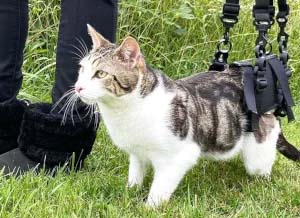
A rear support harness slides up a dog’s back legs like a pair of pants and attaches over the top of their back. Most rear harnesses feature handles that are detachable and adjustable. An adjustable handle is essential, all dogs (and their owners!) are of different heights, and the handle should be long enough that you can comfortably support your dog without bending over or straining your back. Hind leg weakness is incredibly common in pets of all ages. And a dog is more apt to need rear leg support than front leg support.
Remember that pets diagnosed with a degenerative condition or those whose mobility loss will worsen over time need a harness that can change with their mobility needs. Always choose a harness that can adapt and be used with a wheelchair late in life when it becomes necessary.
Support Sling for Mid-Body Support
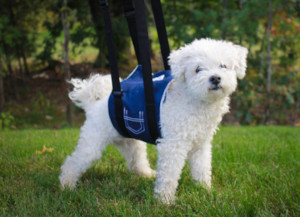
A sling style support is best used for dogs who can still support their own weight but are unsteady on their feet. Vets often recommend a sling support during recovery since they offer more control than a bath towel or scarf.
A support sling offers pets gentle mid-body support, usually wrapping around a dog’s abdomen to lift them from underneath. This is the best harness option for dogs recovering from surgery or injury, especially from TPLO or cruciate surgery. Because the sling avoids both the back and front legs, healing wounds on the knee and hip are safe from rubbing or direct contact from the support system.
Front End Harness for Pet’s with Weak Front Legs
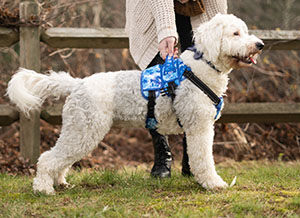
A front lifting harness allows you to support and stabilize a pet with front limb weakness. In most cases, a dog with front leg mobility loss can still stand and take a few steps but will begin to sink, wobble, or lose its balance after a few minutes. A front support harness provides lift and support from under a dog’s chest and abdomen to support a pet’s front legs.
Most front harnesses feature a handle across the top that can lift your dog as you walk next to them.
Total Body Harness for Weak Front and Back Legs
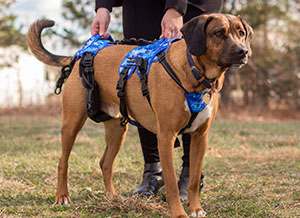
A full support lifting harness supports the entire body. This harness style usually features a two-part system, one for the front legs and one for the back legs. Most total body harnesses are pretty adaptable to suit your dog’s needs. The front and rear harnesses can be used separately or combined to give your dog complete lifting support.
While wearing a full support harness, a pet is supported in both the front and back, which makes a total body harnesses durable and safe enough to lift your dog completely off the ground when needed. This style harness is often the best option for a dog with DM or other progressive mobility condition.
Rear Support Leash
A rear support leash is the simplest, most affordable, and easiest style lifting harness to use. Featuring two loops, the leash slips up the back legs to give a little boost in the rear. This style of rear lifting harness can be put on while a dog is lying down and uses to help them stand up. A rear support leash is ideal for dogs with temporary mobility loss or who need to reduce the pressure on their leg as it heals.
5. A Harness Provides Additional Support During Rehabilitation
Most dogs struggling with mobility issues and leg weakness benefit from canine rehabilitation. Rehab exercises allow them to work on rebuilding their strength, maintain muscle mass, and increase their stamina. Because so many pets in rehab are recovering from surgery, an injury, or trying to stay mobile, they often need assistance standing and walking as they work with their rehab therapist. A harness offers a pet the support they need to keep up in their rehab sessions. Support harnesses can be utilized during underwater treadmill sessions to keep dogs upright and are often used to lift or reduce the pressure on a limb that can’t bear full weight yet.
Dogs are active animals and they are happiest when they are able to run and play. Providing your paralyzed dog or cat a little extra support will help them to live the active lifestyle they need. Still not sure what lifting harness is right for your dog? Talk to your veterinarian or rehab specialist for what style harness is best for your pet. Not only can they help you choose the right harness for your pet, they can teach you how to use it.
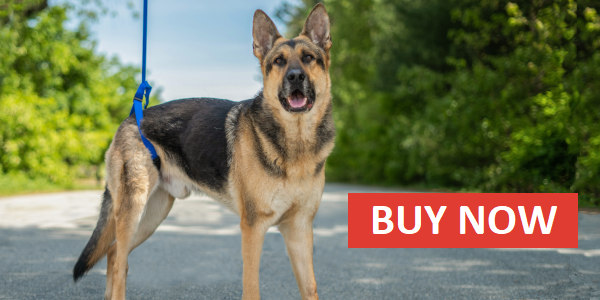
Related Articles:
Did we answer all your questions on “Lifting Harness”?
Tags
What do you think?
Related Articles

New Puppy Checklist: Gear You’ll Need for Your New Dog
Getting a new puppy is really exciting, but before you welcome them home, it’s important to prepare your space for them. Since puppies need a

How Big Do Mini Poodles Get? Vet Reviewed Average Weight & Growth Chart – Dogster
The information is current and up-to-date in accordance with the latest veterinarian research. Learn more » When you buy a Miniature Poodle, you might not

Can Police Dogs Smell Nicotine? Vet Verified Facts & Info – Dogster
The information is current and up-to-date in accordance with the latest veterinarian research. Learn more » While cigarette sales have been declining steadily for decades,

How Old Is 5 in Dog Years? Vet-Approved Guide to Each Size of Dog – Dogster
The information is current and up-to-date in accordance with the latest veterinarian research. Learn more » A common method for calculating a dog’s age is


